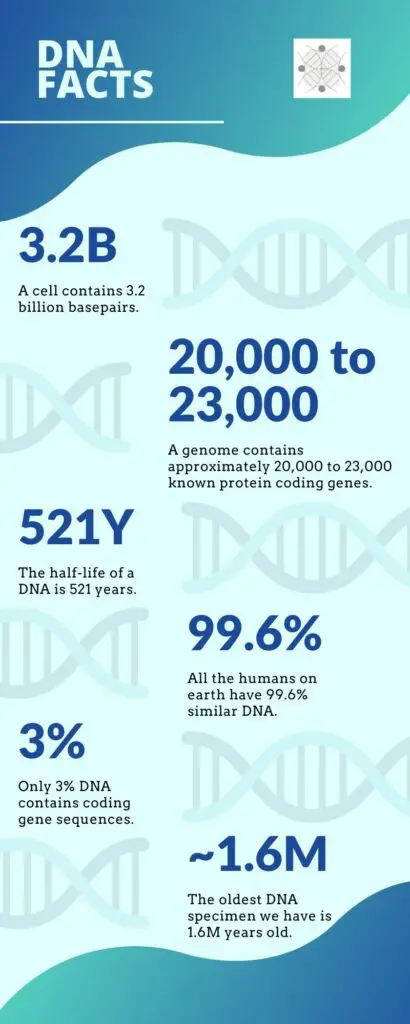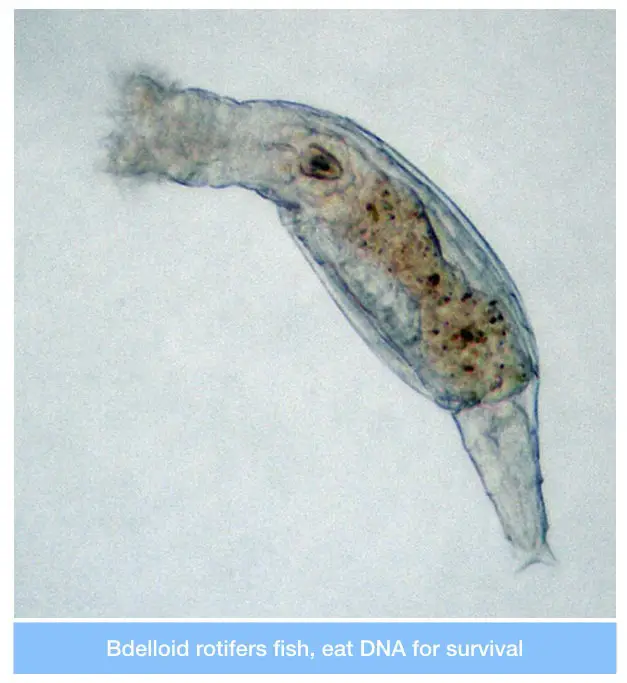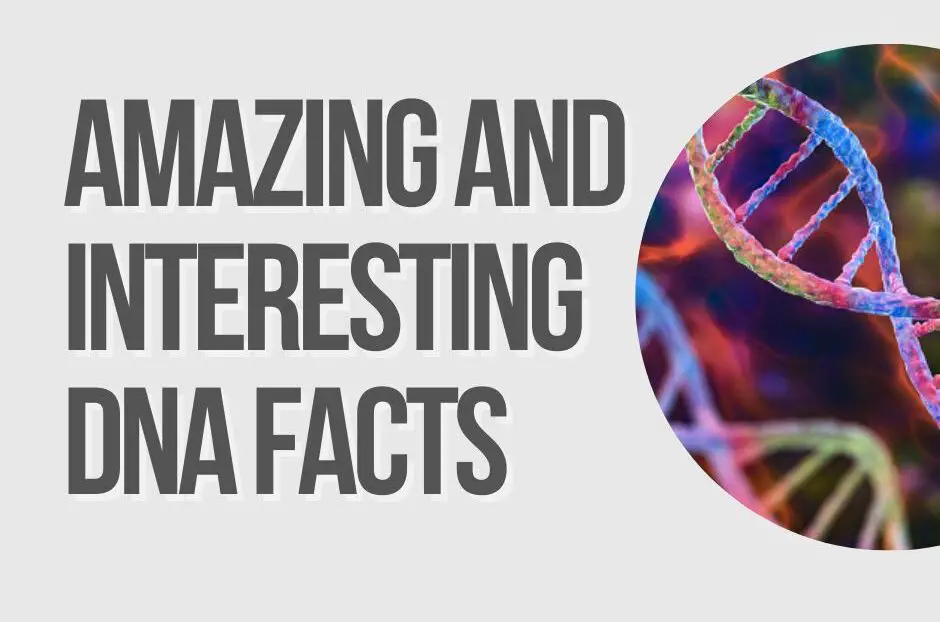“DNA is a deoxyribose nucleic acid, a building block and an inheritance unit of life on earth. DNA is a tiny and sub-microscopic biomolecule. Let’s see 14 Amazing and Incredible DNA facts.”
Snippet:
- We share 50% of our genetic content with our closest siblings.
- The half-life of DNA is 521 years.
- Traces of DNA are also found in space and meteoroids.
- It is believed that DNA came from space to earth.
- The oldest DNA sample we have is millions of years old.
- 8% of our total DNA is inherited from ancient retroviruses.
- DNA can be reprogrammed.
DNA contains vital information for life to survive on the earth that’s the reason why DNA is a blueprint of life. It’s a nucleic acid, present in a cell nucleus and made up of sugar, phosphate and nitrogenous bases.
Until 1953, the chemical structure of DNA was unknown to the world. It was discovered by Franklin R and, postulated and explained by Watson and Crick. The amazing thing about DNA is that it’s present in all living entities on earth and transmits into consecutive generations.
Thus, it passes down traits and preserves the genetic information of an organism. I have amazing content on this topic which you can explore to learn more: DNA (Deoxyribonucleic acid): Definition, Structure, Function, Evidence and Types.
I have completed my PhD in genetics, with a specialization in molecular genetics. I love to read and explore various aspects of genetics and DNA. I read (I don’t know) many books, written tons of articles and am still exploring the topic every day.
So some of the unexplored and amazing things or facts about the DNA, what I know, probably no one knows. Here are 14 amazing and interesting DNA facts. Enjoy the article.

Key Topics:
14 Amazing and Interesting DNA facts:
1. DNA is amazingly and shockingly long:
DNA as an individual molecule is so longer than you think. The approximate length of human DNA from a single cell is 1.8 to 2 meters. Studies suggest that the human body contains roughly 50 trillion cells.
Can you imagine the total length of all bodily DNA? It’s insane. If you stretch all the DNA of a human body (DNA of all 50 trillion cells), we can go to the sun and come back, hundreds of times.
All the human DNA is approx. 67 billion miles long. We go to the moon and come to earth 1,50,000 times. It’s, although just a theoretical calculation, can you believe how long it is? Isn’t it amazing?
2. The content of DNA is just nucleotides
3 billion base pairs a typical genomic DNA contains, meaning a total of 6 billion nucleotides. A single nucleotide is 0.6 nm in size. The nucleotide is made up of sugar, phosphate and a nitrogenous base.
That’s it. It is a long chain of nucleotide units and contains any one nitrogenous base from adenine, thymine, cytosine and guanine.
Do you know?
Marbled lungfish contain 133 billion base pairs in their genome.
Human hair is 40,000 times wider than DNA.
3. Only 3% of DNA is functional:
Yes, you read it right.
Contradicting the insanely larger length of the DNA, only a small portion, around 3% of the total genome can code for any protein. Roughly, 20,000 to 23,000 known genes only account for 2.8 to 3% part of the genome.
This means that 97% of our genome is non-coding or non-function DNA. However, recent findings suggest that this part helps in regulating gene expression. The coding portion replicates, is transcribed into mRNA and translates into a protein.
4. 99.6% of genome among us is similar:
Humans are different from each other due to only 0.4% part of the genome. Meaning, that the total 99.6% portion of our genome is similar.
“What we are is due to only 0.4% of our genome.”
Shockingly, scientific studies demonstrate that although a huge part of the human genome is almost similar, the chances of similarities between two individuals is 1 in 1,000,000,000,000. How diverse our DNA is!
The 4% portion contains 12 million base pairs.
5. The DNA can move:
Scientific understanding, reviews and discoveries show that the DNA is tightly packed on chromosomes. Still… It can move.
As per the previous understanding, the location of DNA is fixed on a chromosome. However, in 1952, Barbara McClintock proved that some DNA sequences can move in the genome and named them, ‘jumping genes.’ Such sequences migrate from one to another place in the genome, produce variability, alter gene function and thereby gene expression.
Such mobile genetic elements provide diversity. 50% of the human and 80% of the Maize genome is made up of jumping genes. Unfortunately, jumping genes are inactive for thousands of years in our genome.
So are just a piece of junk nucleotide sequences at least for now. If you wish to learn more on this topic you can explore our entire series on mobile genetic elements.
- Transposons: A Jumping Entity and a Foe with Benefits.
- Transposons in eukaryotes.
- Role of Transposons in Evolution of Eukaryotic Genome
6. Some DNA were free-living bacteria in the past:
Genetics is mysterious and so DNA is! There are many theories and hypotheses which have yet not been proved. This point is about one such hypothesis postulating that organelle DNA were free-living bacteria in the past.
Unlike the genomic DNA, we and other organisms too, have some DNA in the cytoplasm in membrane-bound organelles. Mitochondria and chloroplast are two organelles that possess their own DNA either in circular and linear form.
They not only have their own DNA but also have replication, transcription and translation machinery. Meaning, organelle DNA is able to synthesize its own protein.
One hypothesis suggests that mitochondria and chloroplast were free-living bacteria in the past, and might settle in our cells for a symbiotic purpose. That’s certainly shocking, right?
7. We are more similar to chimps and bananas:
Genetically, 97% of the human genome is similar to chimpanzees while 50% to 60% of the human genome is similar to the banana. Surprisingly, the rest of the 3% and 50% to 40% genomic content is diverse enough to give us a unique identity and make us different from Chimps and bananas, respectively.
Take a look at the table below for a comparison of a human genome with other species.
| Species | Similarity with the human genome (%) |
| Fruit flies | 61% |
| Cat | 90% |
| Cows | 80% |
| Dog | 94% |
| Drosophila | 60% |
| Human to human | 99.6% |
| Chicken | 60% |
| Mouse | 85% |
8. A type of Twins has 100% similar DNA:
‘No two individuals are genetically similar on earth,’ we know about it but it’s partially true. A special category of twins, referred to as monozygotic twins have almost 100% similar DNA.
Two types of twins are reported in medical literature, dizygotic and monozygotic. Dizygotic twins are actually different because both fetuses develop from two different zygotes but the monozygotic twins originate from a single zygote.
An abnormal event when split the embryo into two parts, two different fetuses develop into monozygotic twins. So ideally, as they are developed from a single zygote, they have similar DNA.
But let me add more value to this point. Over a period of time, factors like interaction with the environment, food habits, habitat and other extrinsic factors change the epigenetic profile of monozygotic twins.
So scientifically, they have similar DNA but different epigenetic profiles.
Related article: Do Identical Twins Have The Same DNA?
9. DNA isn’t the only genetic material:
A few viruses known as retrovirus contain RNA as their genetic material instead of DNA. Examples of retrovirus are HIV, H1N1 and SARS-CoV2. These viruses have highly advanced synthesis machinery which surpasses our defense system and thus are highly contagious.
A mechanism known as reverse transcription helps RNA to convert into cDNA and finally into the transcript for synthesizing a protein. Only retrovirus contains RNA as genetic material in the entire universe.
10. This fish can eat DNA:
A fish named ‘Bdelloid rotifer’ adsorb foreign DNA, eats it and survives. It’s actually an ancient aquatic life and the only of its type that can eat DNA, use it as a source of energy and perform metabolism.

11. A DNA precursor is present in the center of the milky way galaxy:
In an article published by Discovery on Jan 22, 2020, the author reported that the DNA may have outer space origin. Space.com published an article on nebula with a DNA-like structure in the center of the milky way galaxy.
A recent discovery demonstrates that deoxysugar can be synthesized into space, meaning that the origin of DNA is in the galaxy.
12. DNA can remain stable for 2000 years:
We can store DNA for 2000 years under adequate conditions. However, the oldest DNA is 1.2 to 1.65 million years old DNA of a mammoth while the oldest DNA sequenced from any human was 15,000 years old.
There are many ancient DNA samples scientists have, some are in good condition and some are in bad, degraded and in parts. DNA extracted from frozen areas are more intact.
13. DNA contains all the information about life on earth:
It’s now clear that DNA is a memory unit and possesses information to not only make proteins but also to inherit psychological traits. Enzymes, receptors, hormones, receptors, chaperons and immunoglobulins all are proteins and encoded by genes.
Thus our DNA has information regarding which, what and when a particular protein should be synthesized. Not only that by inheriting it into consecutive generations, it also shares this information further.
It is vital to understand that the main role of genetic material is to help us survive and provide adaptation to the present conditions by producing polymorphism.
14. Methylation is a kind of on/off switch for DNA:
Methylation is a process of adding a methyl group to the DNA. When methylation occurs it inactivates the DNA, meaning that it doesn’t allow DNA to form protein. It adds the methyl group at G or C nucleotide and inactivates the sequence.
The major portion of our genome is methylated. Interestingly, a unique methylation pattern is important to make someone unique. During the late phase of pregnancy for a fraction of a second, the entire fetal DNA demethylates and immediately remethylates differently.
This reprogramming by methylation decides the fate of the fetus. It determines which genes express and in which amount.
Wrapping up:
DNA is yet under exploration, although we know much more about DNA compared to what we knew in 19the century. It’s like a supercomputer that stores and expresses information. Decoding the entire human genome takes so much time, manpower, cost, and labor and thus is expensive.
Yet there are many amazing things left about DNA. I will add more new information timely to this article. If you like this article please share it and bookmark the page.


